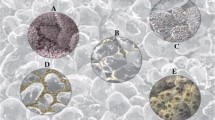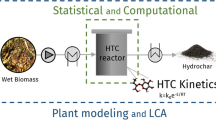Abstract
Two hundred and fifty single first-order Arrhenius reactions are simulated to generate S2 pyrograms at three heating rates 25, 15, and 5 °C·min−1. The activation energy (E) and pre-exponential factor (A) of the reactions simulated follow a long-established trend of those variable values displayed by shales and kerogens. The characteristics of the transformation fraction (TF) profiles (product generation window temperatures) of the simulated single reactions are compared to the TF profiles of recorded shale pyrograms generated by multiple reactions with different E-A values lying near the defined E-A trend. Important similarities and differences are observed between the TF profile values of the two datasets. The similarities support the spread of E-A values involved in shale pyrogram best fits. The differences are most likely explained by the complexity of the multiple kerogen first-order and second-order reactions contributing to the recorded shale pyrograms versus the simplicity and crispness of the single first-order reactions simulated. The results also justify the validity of using the previously described “variable E-A pyrogram-fitting method” of multi-heating-rate shale pyrograms enabling optimizers to choose multiple reactions from an unlimited range of E-A values. In contrast, further doubt is cast on the validity of the constant-A pyrogram-fitting method used by the Easy%Ro technique, in that a distribution of reactions with a single A value is unlikely to represent the complex variety of kerogen macerals observed in shale formations. TF profiles generated by the variable E-A pyrogram-fitting method lie close to the established E-A trend and are likely to provide more realistic TF generation window temperatures than TF profiles generated by the constant-A pyrogram-fitting method.
Similar content being viewed by others
References Cited
Arrhenius, S., 1889. Über die Reaktionsgeschwindigkeit bei der Inversion von Rohrzucker Durch Säuren. Zeitschrift für Physikalische Chemie, 4(1): 226–248. https://doi.org/10.1515/zpch-1889-0416
Bai, H. C., Mao, N., Wang, R. H., et al., 2021. Kinetic Characteristics and Reactive Behaviors of HSW Vitrinite Coal Pyrolysis: A Comprehensive Analysis Based on TG-MS Experiments, Kinetics Models and ReaxFF MD Simulations. Energy Reports, 7: 1416–1435. https://doi.org/10.1016/j.egyr.2021.09.100
Burnham, A. K., Sweeney, J. J., 1989. A Chemical Kinetic Model of Vitrinite Maturation and Reflectance. Geochimica et Cosmochimica Acta, 53(10): 2649–2657. https://doi.org/10.1016/0016-7037(89)90136-1
Burnham, A. K., Peters, K. E., Schenk, O., 2017. The Evolution of Vitrinite Reflectance Models. American Association of Petroleum Geologist Search and Discover Article, 41982: 24
Clarkson, C. R., Solano, N., Bustin, R. M., et al., 2013. Pore Structure Characterization of North American Shale Gas Reservoirs Using USANS/SANS, Gas Adsorption, and Mercury Intrusion. Fuel, 103: 606–616. https://doi.org/10.1016/j.fuel.2012.06.119
Dieckmann, V., 2005. Modelling Petroleum Formation from Heterogeneous Source Rocks: The Influence of Frequency Factors on Activation Energy Distribution and Geological Prediction. Marine and Petroleum Geology, 22(3): 375–390. https://doi.org/10.1016/j.marpetgeo.2004.11.002
Espitalié, J., Madec, M., Tissot, B., 1980. Role of Mineral Matrix in Kerogen Pyrolysis: Influence on Petroleum Generation and Migration. AAPG Bulletin, 64: 59–66. https://doi.org/10.1306/2f918928-16ce-11d7-8645000102c1865d
Gorbachev, V. M., 1975. A Solution of the Exponential Integral in the Non-Isothermal Kinetics for Linear Heating. Journal of Thermal Analysis, 8(2): 349–350. https://doi.org/10.1007/bf01904012
Hackley, P. C., Lewan, M., 2018. Understanding and Distinguishing Reflectance Measurements of Solid Bitumen and Vitrinite Using Hydrous Pyrolysis: Implications to Petroleum Assessment. Bulletin of the American Association of Petroleum Geologists, 102(6): 1119–1140. https://doi.org/10.1306/08291717097
Hui, S. S., Pang, X. Q., Jiang, F. J., et al., 2024. Quantitative Effect of Kerogen Type on the Hydrocarbon Generation Potential of Paleogene Lacustrine Source Rocks, Liaohe Western Depression, China. Petroleum Science, 21(1): 14–30. https://doi.org/10.1016/j.petsci.2023.09.004
Jarvie, D., Claxton, B., Henk, F., et al., 2001. Oil and Shale Gas from the Barnett Shale, Ft. Worth Basin, Texas. AAPG National Convention, June 3–6, 2001, Denver
Jones, R. W., 1987. Organic Facies. In: Brooks, J., Welte, D., eds., Advances in Petroleum Geochemistry. Academic Press, New York. 1–90
Katz, B. J., Lin, F., 2021. Consideration of the Limitations of Thermal Maturity with Respect to Vitrinite Reflectance, Tmax, and other Proxies. AAPG Bulletin, 105(4): 695–720. https://doi.org/10.1306/09242019261
Labus, M., Matyasik, I., Ziemianin, K., 2023. Thermal Decomposition Processes in Relation to the Type of Organic Matter, Mineral and Maceral Composition of Menilite Shales. Energies, 16(11): 4500. https://doi.org/10.3390/en16114500
Lewan, M. D., 1985. Evaluation of Petroleum Generation by Hydrous Phrolysis Experimentation. Philosophical Transactions of the Royal Society of London Series A, Mathematical and Physical Sciences, 315(1531): 123–134. https://doi.org/10.1098/rsta.1985.0033
Lewan, M. D., Pawlewicz, M. J., 2017. Reevaluation of Thermal Maturity and Stages of Petroleum Formation of the Mississippian Barnett Shale, Fort Worth Basin, Texas. Bulletin of the American Association of Petroleum Geologists, 101(12): 1945–1970. https://doi.org/10.1306/01251716053
Li, Y. Y., Zhou, S. X., Li, J., et al., 2024. Research Progress of Hydrocarbon Generation Kinetics Based on Gold Tube. Journal of Natural Gas Geoscience, 9(1): 53–67. https://doi.org/10.1016/j.jnggs.2023.11.005
Mastalerz, M., Drobniak, A., Stankiewicz, A. B., 2018. Origin, Properties, and Implications of Solid Bitumen in Source-Rock Reservoirs: A Review. International Journal of Coal Geology, 195: 14–36. https://doi.org/10.1016/j.coal.2018.05.013
Peters, K. E., Cassa, M. R., 1994. Applied Source-Rock Geochemistry. In: Magoon, L. B., Dow, W. G., eds., The Petroleum System: From Source to Trap. American Association of Petroleum Geologists Memoir, 60: 93–120. https://doi.org/10.1306/m60585c5
Peters, K. E., Burnham, A. K., Walters, C. C., 2015. Petroleum Generation Kinetics: Single Versus Multiple Heating-Ramp Open-System Pyrolysis. AAPG Bulletin, 99(4): 591–616. https://doi.org/10.1306/11141414080
Peters, K. E., Burnham, A. K., Walters, C. C., 2016. Petroleum Generation Kinetics: Single versus Multiple Heating-Ramp Open-System Pyrolysis: Reply. AAPG Bulletin, 100(4): 690–694. https://doi.org/10.1306/01141615244
Peters, K. E., Burnham, A. K., Walters, C. C., et al., 2018. Guidelines for Kinetic Input to Petroleum System Models from Open-System Pyrolysis. Marine and Petroleum Geology, 92: 979–986. https://doi.org/10.1016/j.marpetgeo.2017.11.024
Tissot, B. P., Espitalié, J., 1975. L’evolution Thermique de La Matière Organique des Sédiments: Applications D’une Simulation Mathématique. Potentiel Pétrolier des Bassins Sédimentaires de Reconstitution de L’histoire Thermique des Sédiments. Revue de L’Institut Français du Pétrole, 30(5): 743–778. https://doi.org/10.2516/ogst:1975026
Tissot, B. P., Welte, D. H., 1984. Petroleum Formation and Occurrence. Springer-Verlag, New York. 699
Tegelaar, E. W., Noble, R. A., 1994. Kinetics of Hydrocarbon Generation as a Function of the Molecular Structure of Kerogen as Revealed by Pyrolysis-Gas Chromatography. Organic Geochemistry, 22(3/4/5): 543–574. https://doi.org/10.1016/0146-6380(94)90125-2
Ungerer, P., Pelet, R., 1987. Extrapolation of the Kinetics of Oil and Gas Formation from Laboratory Experiments to Sedimentary Basins. Nature, 327(6117): 52–54. https://doi.org/10.1038/327052a0
Ungerer, P., 1990. State of the Art of Research in Kinetic Modelling of Oil Formation and Expulsion. In: Durand, B., Behar, F., eds., Advances in Organic Geochemistry. Organic Geochemistry, 16(1–3): 1–25
Waliczek, M., Machowski, G., Poprawa, P., et al., 2021. A Novel VRo, T, and S Indices Conversion Formulae on Data from the Fold-and-Thrust Belt of the Western Outer Carpathians (Poland). International Journal of Coal Geology, 234: 103672. https://doi.org/10.1016/j-coal.2020.103672
Waples, D. W., 2016. Petroleum Generation Kinetics: Single versus Multiple Heating-Ramp Open-System Pyrolysis: Discussion. AAPG Bulletin, 100(4): 683–689. https://doi.org/10.1306/01141615146
Waples, D. W., Yang, S. Y., 2023. A Method for Assigning Pre-Exponential Factors for Kerogen Kinetics, Calibrated with Easy% RoDL, and Comparison with EASY%Ro. Advances in Geo-Energy Research, 7(1): 1–6. https://doi.org/10.46690/ager.2023.01.01
Wood, D. A., 1988. Relationships between Thermal Maturity Indices Calculated Using Arrhenius Equation and Lopatin Method: Implications for Petroleum Exploration. AAPG Bulletin, 72(2): 115–135. https://doi.org/10.1306/703c8263-1707-11d7-8645000102c1865d
Wood, D. A., Hazra, B., 2018. Pyrolysis S2-Peak Characteristics of Raniganj Shales (India) Reflect Complex Combinations of Kerogen Kinetics and other Processes Related to Different Levels of Thermal Maturity. Advances in Geo-Energy Research, 2(4): 343–368. https://doi.org/10.26804/ager.2018.04.01
Wood, D. A., 2018. Kerogen Conversion and Thermal Maturity Modelling of Petroleum Generation: Integrated Analysis Applying Relevant Kerogen Kinetics. Marine and Petroleum Geology, 89: 313–329. https://doi.org/10.1016/j.marpetgeo.2017.10.003
Wood, D. A., 2019. Establishing Credible Reaction-Kinetics Distributions to Fit and Explain Multi-Heating Rate S2 Pyrolysis Peaks of Kerogens and Shales. Advances in Geo-Energy Research, 3(1): 1–28. https://doi.org/10.26804/ager.2019.01.01
Wood, D. A., 2022. Shale Kerogen Kinetics from Multiheating Rate Pyrolysis Modeling with Geological Time-Scale Perspectives for Petroleum Generation. Sustainable Geoscience for Natural Gas Subsurface Systems. Elsevier, Amsterdam. 159–195. https://doi.org/10.1016/b978-0-323-85465-8.00001-7
Acknowledgments
The author is grateful to the editors and anonymous reviewers for their constructive comments. The final publication is available at Springer via https://doi.org/10.1007/s12583-024-1981-0.
Author information
Authors and Affiliations
Corresponding author
Ethics declarations
The author declares that he has no conflict of interest.
Rights and permissions
About this article
Cite this article
Wood, D.A. Kerogen Kinetic Distributions and Simulations Provide Insights into Petroleum Transformation Fraction (TF) Profiles of Organic-Rich Shales. J. Earth Sci. (2024). https://doi.org/10.1007/s12583-024-1981-0
Received:
Accepted:
Published:
DOI: https://doi.org/10.1007/s12583-024-1981-0




